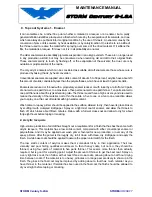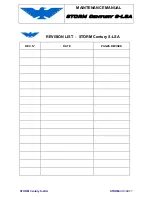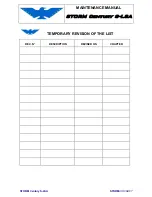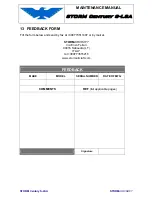
MAINTENANCE MANUAL
STORM Century S-LSA
STORM Century S-LSA
STORMAIRCRAFT
CHAPTER 11
PAINTING
A. Surface Preparation
It goes without saying that no finish will last long if the metal surface has not been properly
prepared. The metal must be thoroughly cleaned and microscopically roughened to provide a
bond for the finish. A primer applied to the metal provides a sandwich to which the topcoats
can adhere. If the metal has already been painted, this paint must be thoroughly
reconditioned or completely removed before a new finishing system can be applied.
1. Paint stripping
There are two types of paint strippers which can be used to remove the finish from an
airplane. The solvent type, which is a clear liquid, is not very effective for stripping an airplane
because of the fast rate of evaporation of its active solvents. These solvents do not have
time to penetrate the film.
Wax-type removers are most generally used when stripping an entire airplane because the
wax holds the active solvents against the surface until they penetrate it. Methylene chloride is
the active agent in this type, and it penetrates the film of enamels or some primers to expand
them so they pucker up and break their bond with the metal. After the bond has been broken,
the wax gets between the film and the metal, preventing its re-sticking. Never remove, or
attempt to remove, the stripper until all of the area has puckered up, or is completely
softened. Flushing the stripper before it has finished its work defeats its effectiveness. If an
area dries before it puckers or softens, apply some more stripper and allow it to remain until
its action is complete.
To properly strip a surface, the remover is applied with a bristle brush, a non-atomizing spray,
or a roller. If it is brushed on, a heavy, wet coat should be applied, brushing only in one
direction. After this has been done, lay an inexpensive poly- Ethylene drop cloth over the surface
to hold the solvents until they have had ample time to penetrate the film. Acrylic lacquer will not expand
or wrinkle when the stripper works on it. It will only soften. As an area is softened, the drop cloth should
be rolled back, exposing a small section of the softened finish. This is scraped off with a piece of Plod-
glass or a rubber squeegee, and the cleaned area washed with a rag wet with methyl-ethyl-ketone
(MEK) or acetone. Roll the drop cloth back and remove more finish.
One of the most important parts of the paint stripping process is the complete removal of every trace of
wax left on the surface from the stripper. Careful scrubbing with acetone or MEK after removing the
acrylics generally leaves the surface free from wax, provided all of the faying strips and the area around
the rivets, fittings, and joints are flushed out with the solvents in a power spray gun.
Enamel or polyurethane residue must be flushed off with water, and the entire surface scrubbed with a
good solvent. MEK or acetone is generally suitable, but a less expensive solvent such a tuluol or xylol
is more desirable. Lacquer thinner is not satisfactory because it will not absorb the wax; it will only
spread it ground. Any wax left on the surface will tend to be absorbed by the solvents in the finish and
brought up into the system and locked in, preventing its drying.
poryurethane film is readily attacked by the solvents, but if it is held against the surface long enough,
the active agent will loosen the bond to the primer and release the film. The surface formed by a






































